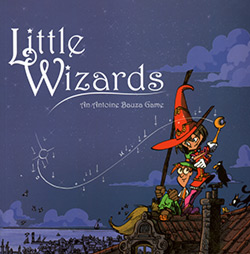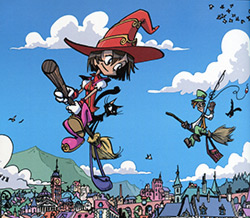
|
About OgreCave and its staff
|

|
by Merwin
Little WizardsPublished by Crafty Games (2013)Designed by Antoine Bauza and others Art by Arnü West and others 128 full-color pages, softcover $24.95 Is there an actual market for younger RPG players? We’re talking dedicated game, not dumbed-down D&D or Hero with a helping hand. In my day, we were happy just running around playing cops and robbers, cowboys and injuns, haunted house, and so on…. Of course, I plead the 5th when it comes to playing Doctor... Antoine Bauza is probably best known for his design of the 7 Wonders card-drafting game. Crafty Games has brought his RPG from France into the U.S. market. Is it worth playing? Is it worth buying? Honestly, these are pretty tough questions.
What It Is
Everyone gets the Broom-Riding power for free. I attribute this affectation to Harry Potter, since before Rowling’s time, I always associated brooms with witches, not wizards. Oh, well. Players then decide if their li’l Wizard was born with magical powers (Sorceror), or whether they learned them (Mage). Sorcerers get to choose two powers from among Alchemy, Divination, and Spellcasting. Mages choose two powers from among Conjuring, Shapechanging, and Spellcasting. As with stats, you rate your three powers as Good, Better, and Best. Every character gets a familiar, which is always black. (The player on your right gets to roleplay your familiar, by the way.) There are a number of questions and brief tables to inspire fledgeling roleplayers to better describe their characters’ backgrounds. Characters are modestly powerful in the beginning of the game, and the experience-point-based advancement is relatively brisk.
The System There are a number of other minor tweaks, including teamwork, obstacles, complications, setbacks, and the like, with modifiers resulting in +/-1 each, or a reroll under certain circumstances.
What Happens and Where Adventures can be violent, but they are not inherently so. There are no Shadowrun-style steal the macguffin adventures, because stealing is wrong. In fact, this game is as far from hack-and-slash as you can get. It’s a playground for kids to exercise their imaginations, not necessarily vent their frustrations, figuratively or tactically. The strangest thing is that through it all, they’re still kids. They can fly brooms, because that’s magic. But “borrow” and drive a car? No way, even though Coinworld has cars. You’ll get in big trouble. From whom? Not really sure. Them? Whoever They are. The book includes three adventures, with many opportunities for exploration – lots of open-ended plot prompts. The first adventure starts with no preamble. The next two are prefaced by short introductions to the Coinworld locations in which those adventures occur.
The Good There’s no rhyme or reason specified as to why Coinworld exists in this duality. Nor is there any firm mechanism for traveling from Heads to Tails. You might fall asleep in Heads and wake up in Tails. Or fall down a well, which turns out to be a gate. Or cast a spell that moves you between the two halves. One of the adventures includes a magic item that is a set of coins that allows one to travel from one side of Coinworld to the other, depending on how a coin lands when it’s flipped. The whole thing is delightfully vague and wondrous – freeing. Personally, I like the idea of having a fully layered duality, where everything is exactly the same between the two halves, yet different. But that’s not quite how the world is designed out of the box, so I digress. Really, as slim as this book is, there’s a lot of fertile ground for imaginative storybuilding.
The Bad The other bad thing is the lack of violence. Murder hobos aside, my generation was pretty much raised on violent cartoons. Fictionally speaking, violence is a “natural” way to solve problems. Even these days, kids have Kung Fu Panda to guide them. Maybe we counsel against magnifying glass guided ant genocide these days, but that doesn’t stop the imagination. I guess avoiding nearly all possibility of violent options keeps the world from devolving into a cacophony of mayhem. I’m not saying you need violence. Hmm. Maybe I am. Or at least, there should be a better way to deal with it, because it’s the monstrous enraged elephant in the room. But since the book is written with 6- to 10-year-old kids in mind, confronting the issue of how to deal with in-game violence is frustratingly absent.
Should You Buy It? Also, with so little to draw from, fledgling Narrators will likely struggle with adventure design, pacing, and mediation skills. Sure, there are three adventures included, but after that? Making the leap from noob to conventional roleplayer hasn't been adequately captured. They certainly teach by example, but I would have preferred to see a sort of cookie-cutter approach to adventure design for beginners. After all, the author does have character building assistance in the form of tables. Something similar could have been done for storybuilding. I remember when I made the leap from high school to college, there was quite a bit of shell shock and the sudden ramp-up in course difficulty and social challenges. I get the feeling that when you play this game with youngsters, they will experience something very similar when they “graduate” to conventional roleplaying. Then again, maybe Antoine’s trying to cultivate unconventional roleplayers. Still, I recommend picking this up only if you've got youngsters you're trying to gently introduce to roleplaying, or if you need a little inspiration for really innovative world creation.
Links:
Related OgreCave podcasts/videos:
OgreCave.com: Crafty Games at KublaCon 2014 - Interview with Patrick Kapera of Crafty Games, with info on Mistborn RPG's "Terris: Wrought of Copper" and "Alloy of Law", as well as the Little Wizards RPG and Z Corps. With Ogre-in-Chief Allan Sugarbaker. (recorded at KublaCon 2014)
|
||||

 Character Building
Character Building